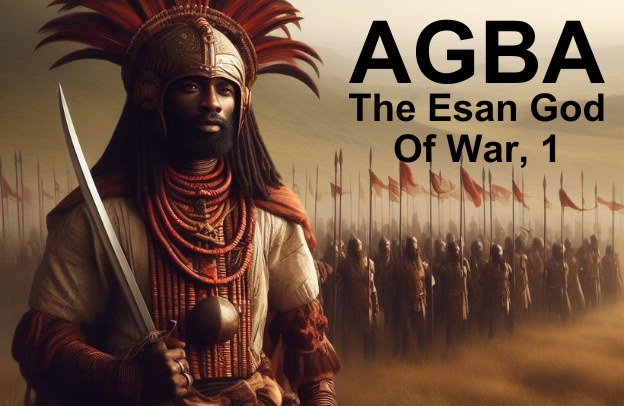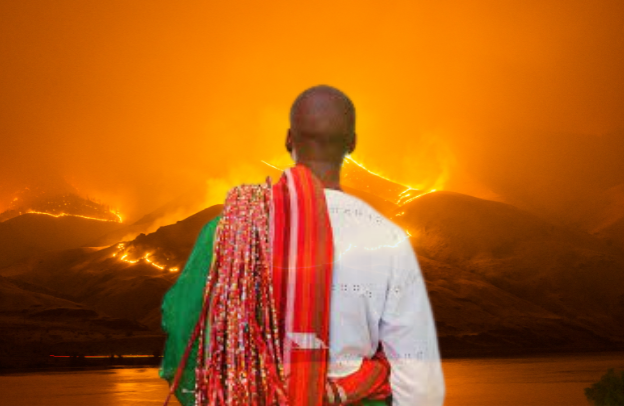The Origin Of Uromi And Esanland, Nigeria (Agba: The Esan God Of War, 1)

Welcome to the first in our series of articles on Agba, the Esan God of war. This is part of our Life & Legacy Series where we talk about the lives of prominent people (both in Africa and in the diaspora) who have impacted our lives and our society. This first part of the series is about Uromi, the land of Agba. The story starts here and right now.
Want to learn more about storytelling? Start by downloading the first chapter of The Storytelling Mastery.
Though we will consider Esanland within the context of the Benin Empire, it’s essential to acknowledge that the existence of people in Esanland predates most of the historical records we often quote about Esan people and their heritage.
Today as we speak, there are approximately 2.5 million Esan people, constituting one of the largest ethnic groups in Edo State, Nigeria. Historical accounts affirm that during the reign of Oba Ewuare in the fifteenth century, the people who would later be referred to as Esan migrated from Benin in several waves. This was due to the stringent rule imposed by the Oba, the highest authority in order of hierarchy in the Benin kingdom.
This, according to the narrative, is what led to the origin of the Esan people. But now there are some questions we might need to contend with. You can consider them as a curiosity:
- Was Esanland devoid of inhabitants until the fifteenth century, when the migrants from Benin would have gotten there and settled?
- Assuming the migrants didn’t meet anybody in their destination, about 2,814 square kilometers, did they find any evidence of people who would have been there before them?
- If on the other hand, they did meet some people, who were these people and what can we learn about them today?
Of course, these three fundamental questions will need to be answered by Esan historians, linguists, and cultural experts who must examine the sociocultural and religious relics of the Esan people, particularly in the period of pre-European contamination.
So, we must think deeper, and I mean thousands of years deeper if we must understand more about the people and the land of Esan.
Over 3000 years of history in Esanland
Well, as part of my ongoing research on the Life & Legacy Project, earlier referred to, I came across an online publication that discussed Esan archaeology as part of a larger archaeological work in Nigeria. The book “Historical Archaeology in Nigeria” indicates that Esan land has been inhabited for at least the past 3000 years.
On page 180 of the book, you will read the following: “The Ishan (Esan) forest was probably entered and settled by people using neolithic grand stone axes 2000 to 3000 years ago… By about A.D. 500, early users of iron tools in northern Ishan (Esan) dug low banks around family compounds, possibly the first gigantic earthwork of a rural cluster that was to develop. As the settlement grew in size and complexity, so ditches and banks became deeper and larger, superimposing their territories over long-deserted compound banks.”
What is Neolithic?
The Neolithic period, also known as the New Stone Age, was a significant era in human history characterized by the transition from a lifestyle of hunting and gathering to one of agriculture and settled farming communities. This period roughly spanned from around 12,000 to 2,000 BCE, although the timing may vary across different regions of the world.
Coming back to the book, it went on to state that the mass refugee movement from Benin to Esan may have taken place in the mid-15th century, following the action of Oba Ewuara, but that “cannot explain Ishan (Esan)’s high population density and commercial wealth, (based on gold in Ekpoma and cotton in Uromi)”. The book, ‘Historical Archaeology in Nigeria’, published in 1998 by Africa World Press is edited by Kit W. Wesler, and available online if you want to get a copy and read more for yourself.
Thinking back to the earthwork mentioned in the book, I remember growing up in Uromi and Amedokhian to be precise, and coming across those earthworks when as little children we went to hunt for rabbits and other rodents in the bush. I remember more than once I asked about the origins and significance of those earthworks, but I never got any satisfactory answer. Well, I was just a child, so I abandoned my curiosity for other necessities of life.
Of the claim from the book, Historical Archaeology in Nigeria, there was not much independent hard evidence on my part to back the 3000 years of human history in Esanland. However, I remain seriously curious because I never heard of that before even though I grew up to age 24 before I left Nigeria in August of 2004.
Intrigued by this revelation, I quickly reached out to one of the sources that were mentioned in the document who happened to be based in Moscow at the time. Upon receiving a response, however, it became apparent that the source was no longer involved in the project and was unwilling to share further details about his findings.
Quite frankly, I am still looking for more information about that story. But this is my thinking: unlike most of the ancient Benin empire, the Esan territory extends to the river Niger after merging with river Benue in Lokoja and following through to the Niger Delta. That means Esanland would have witnessed several transitions of Africans migrating from the north to southern Africa and vice versa.
This is because human migration has always followed natural formation as mountain ranges, valleys, and most importantly, the sources of life, which are water and, in this case, the river Niger.
I am saying this to imply that, the land of Esan like other parts of the African continent has probably been inhabited for several thousands of years before the arrival of migrants from Benin in the mid-fifteenth century. This should be a question of common sense.
Having said that, let’s zoom in on a smaller part of Esanland as a reference point in the series, Uronmun or Uromi as it’s currently known today. In this series, we are going to rely on the popular narrative of the origin of the Esan people from the Benin empire.
Uromi, the land of Agba
Uromi is a small city, situated in the northeastern region of Esan, a sub-ethnic group within Edo state, Nigeria. The history of the Esan people is deeply intertwined with the Benin Empire at various points.
Due to its historical relevance and location, Uromi is the most densely populated area in Esanland, with its roots traced back to more than two waves of migration, according to different reports.
See The History Of Uromi Clan Edo State to learn more.
The first wave would have occurred between 900 and 1400 AD, and it involved migrants from Benin and neighboring regions, forming a community centered around farming and hunting.
Various sources say that there was no formalized government structure in the early time of settlement in Uromi. The second wave would have been around 1460, which saw organized mass emigration from Benin during the reign of Oba Ewuare, the then-reigning head of the Benin empire.
From the second wave on, the people of Uromi started to have a more organized and stable society. Currently, as we speak, Uromi has a population of roughly 100,000 inhabitants according to Geoview.
As of our last check, the predominant ethnic groups that are swelling the local population are migrants from Igbo extraction, Yoruba, and a sizable number and Hausa ethnic groups. They are coming in because of the relatively stable local economic activities and the general hospitality of the Esan people.
The economy of Uromi
Uromi’s commercial activity is dominated by “Ekiole”, the Uromi main market, which facilitates trade for local farmers and traders alike, including those coming from other parts of Esanland. The market is open every five days and is one of the most important open markets in the whole of Esanland.
The city’s economy is primarily driven by local farming and growing trading activity, including the informal sector of the economy. These are highly evident along Mission Road, Ubiaja Road, between Angle 90 to Angle 80, and Afuda Road to New Agbor Road, just to name a few.
This is sometimes complemented by a few government contributions in terms of infrastructures such as schools and a few other institutions like banks and more. For example, Uromi is home to such establishments as the Institution of Construction Technology and Management (NICTM) and the Federal Science And Technology College.
The traditional religious practices in Uromi are reminiscent of Bini traditions, and they coexist with influences from Christianity and Islam as a legacy of colonial intervention in Esanland.
It’s important to note that Uromi people cherish their cultural heritage through traditional festivals like OTO-UROMI and Amukpe, Ihulan (The New Yam festival) through which they honor the land and usher in the new yams, respectively.
Geographically, Uromi lies in the northeastern part of Esan, experiencing a climate typical of southern Nigeria with two rainy seasons and a dry spell in August, or what is locally referred to as the “August Break”. These climatic conditions influence the agricultural practices among Uromi people, especially since there is no mechanized or irrigated system of farming in Uromi.
Politically, Uromi operates under the governance of the Esan-North-East local government council, divided into eleven wards. That leads us to the leadership and lineage in Uromi.
The Leadership Lineage In the Uromi Kingdom
Ijesan, sometimes written “Ichesan” was the first Onojie of Uromi. The term “Onojie” can be translated as king or the traditional ruler of the Uromi people, just as it is across Esanland.
The leadership lineage in Uromi includes such important rulers as Agba, Ikenoa, King Ogbidi, and a long list of others, with the present traditional ruler being HRH Anslem Edenojie II (the Ojuromi of Uromi Kingdom).
The Uromi kingdom follows a hereditary monarchy system, with the king (Onojie) leading with the assistance of a body of chiefs. The kingship, established 5 and a half centuries ago (1463) by Oba Ewuare, has been passed down through inheritance.
Check out also our previous article – Religion And Spirituality Among The Esan People of Nigeria
The leadership structure includes the council of elders overseeing different villages, with an indigenous elderly man heading each council, holding legislative authority and the power to enforce punishments.
Such punishments must, of course, not conflict with the Nigerian constitution because being a republic, the Nigerian constitution remains the supreme law across the federal republic of Nigeria.
When it comes to the respective villages, each village is headed by the eldest man alive, (Odiowele) and he is usually supported by the council of elders in the village through which they enforce peace and promote the continuity of the village. Of course, like across Esanland, Uromi people have other groups and social stratification such as:
- Ighene – Mature men who are usually responsible for the hardest works on the land like road construction and maintenance, erecting of buildings, digging graves, organizing the people for defense or attack in time of war,
- Ebonughele – Adolescent, mostly for sanitary works, like clearing up the road and more.
- There are also women groups among others with their different layers of roles during public and communal functions.
Uromi people and their cultural heritage
At this point, it needs to be pointed out that Uromi, like most Esan people, are very proud of their cultural heritage and they are willing to fight for it in the event of a real danger to their interest. They have always fought for their right as a people.
In the early years of Uromi, the second leader in succession, Agba takes on the challenge from Oba Ozolua and we will discover later in this series (Agba, The Esan God of War), how that would lead to the death of Ozolua and Agba in Esanland. That was the only few cases if there was another in the whole history of the Benin empire that the Oba did not return from a battle.
Years, later when the British colonial army invaded Uromi, the local leader organized the Uromi army to fight. We will also consider that in this series. Hundreds of years later, another child was born in Uromi, by the name Anthony Enahoro, and he would be the first to move the motion for Nigerian independence.
This is only to show that there is no coincidence here. Instead, this is the true spirit of the Uromi and Esan people, and this is what we are talking about in this series on Agba, the Esan God of war. In the next presentation, we will talk about Agba N’Ojie himself, the Esan God of War. So, get ready for that.
Want to learn more about storytelling? Start by downloading the first chapter of The Storytelling Mastery.






